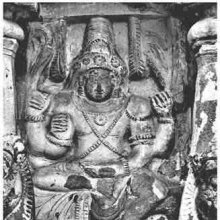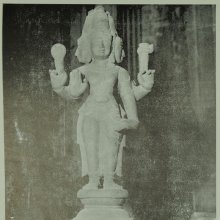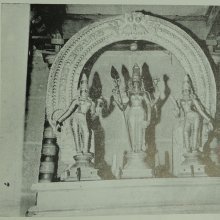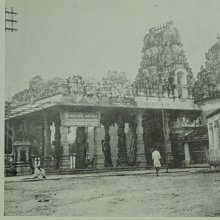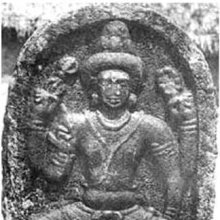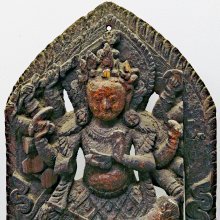Subrahmanya, Subrahmaṇya, Su-brahmanya: 14 definitions
Introduction:
Subrahmanya means something in Hinduism, Sanskrit. If you want to know the exact meaning, history, etymology or English translation of this term then check out the descriptions on this page. Add your comment or reference to a book if you want to contribute to this summary article.
Images (photo gallery)
In Hinduism
Shilpashastra (iconography)
Source: Wisdom Library: Elements of Hindu Iconograpy1) Subrahmaṇya is almost exclusively a South Indian deity. There is not a village, however small, which does not possess a shrine for Subrahmaṇya. In face the popularity of this deity with the South Indian is so great as to induce him to build shrines for him in all places such as towns, villages, gardens, mountain tops and other odd places. strangely enough Subrahmaṇya is less known and less worshipped in Northern India; there are not many temples of this god in Northern India. In Bengal it is stated that he is worshipped by disreputable women on certain occasions, while in the Bombay Presidency no sumaṅgali (a woman whose husband is alive) would visit the temple of Kārttikeyasvāmin (Subrahmaṇya).
The birth of Kārttikeya or Subrahmaṇya is given at some length in the Bālakāṇḍa of the Rāmāyaṇa. In another place in the same work the birth of Kārttikeya is described differently. The Vana-parvan of the Mahābhārata has another account of the birth of Kārttikeya. Almost the same account is given in all the later works such as the Kumārasambhava, etc.
The āgamas state that the temple for Subrahmaṇya may be constructed on all sides of a town except the east and it might face any direction. These temples may be built in captial cities, in towns, villages, on the tops of mountains, on the banks of rivers, in gardens, forests or under large trees. They may stand separately as svayampradhāna temple or be attached to some others, such as that of Śiva. Different kinds of central shrines are prescribed for the temple of Subrahmaṇya; these may contain from one to seven talas (storeys) and may be surrounded by prākāras or circuits and adorned wityh maṇḍapas or pavillions, and other adjuncts. As usual the size of the shrine of this god is also determined with reference to the height of the image to be set up in it. The temples of Subrahmaṇya are to be adorned with either peacocks or elephants placed in the corners of the vimāna, where generally Garuḍa or Nandi is seen in the temple of Viṣṇu or Śiva respectively.
In a svayampradhāna temple of Subrahmaṇya there are required to be set up eight parivāra-devatas, namely,
- Yakṣendra,
- Rākṣasendra,
- Piśāchendra,
- Bhūtarāṭ,
- Gandharva,
- Kinnara,
- Daityanāyaka and
- Dānavādhipa.
Besides the parivāra-devatās mentioned above, the temple of Subrahmaṇya is required to have eight śarīra-pālakās or body-guards. They are named
- Ṣaṇmukha,
- Śaktipāṇi,
- Kārttikeya,
- Guha,
- Skanda,
- Mayūravāhana,
- Senāni, and
- Śaktihastavān.
Subrahmaṇya is know by several names, the chief among them are Kārttikeya, Ṣaṇmukha, or Ṣaḍānana, Śaravaṇabhava or Sarajanman, Senāni, Tārakajit, Krauñchabhettā, Gaṅgāputra, Guha, Agnibhū, Skanda and Svāminātha. Most of his epithets have references to the circumstances of his birth.
Corresponding to the various names of Subrahmaṇya are images whose descriptions are found in almost all the āgamas. The following are some of the important aspects of Subrahmaṇya dealth with in the Kumāra-tantra, viz.,
- Śaktidhara,
- Skanda,
- Senāpati,
- Subrahmaṇya,
- Gajavāhana,
- Śaravaṇabhava,
- Kārttikeya,
- Kumāra,
- Ṣanmukha,
- Tārakāri,
- Senāni,
- Brahma-śāsta,
- Valli-kalyāṇa-sundaramūrti,
- Bālasvāmi,
- Krauñchabhetta and
- Śikhivāhana.
2) Subrahmaṇya (aspect of Skanda (Subrahmaṇya?), according to the Kumāra-tantra). This aspect should be of the colour of Kuṅkuma (saffron) and be adorned with keyūra, hāra and other ornaments. One of the right hands should be held in the abhaya and in the rest must be the śakti, kukkuṭa, and a padma. The colour of this aspect of the deity should be that of the rising sun and that of the sandal paste and the clothing red. Or, the figure may have only two arms of which one should rest upon the hip (kaṭyavalambita) and the other hand be held in the abhaya pose.
Source: Shodhganga: The significance of the mūla-beras (śilpa)Subrahmaṇya (सुब्रह्मण्य) is the name of a deity depicted in various temples:
The Thillai Nataraja Temple in Cidambaram (Chidambaram), [Śiva temple].—(a) Subrahmaṇya is found standing in vaiśākha-sthānaka with four hands. In dance, Subrahmaṇya is represented as standing in vaiśākha-sthānaka. Valli and Deivānai are found on either side of the lord in their usual postures. (b) Subrahmaṇya is found seated in sukhāsana posture on the peacock with six pairs of hands. Valli and Deivānai are found on either side of Subrahmaṇya in their usual postures. (c) Subrahmaṇya is found seated on the peacock in sukhāsana. He is found with his usual four hands.
The Adi Kumbeswarar Temple (Ādi Kumbheśvara) in Kumbakonam (Kumbhakonam), [another Śiva temple].—Subrahmaṇya is found seated in sukhāsana with six pairs of hands and six faces. Valli and Deivānai are found on the either side of the lord.
The Nellaiappar Temple at Tirunelveli, [another Śiva temple].—Subrahmaṇya is seen standing with Valli to his right. He is shown as a beardless young man. His forehead is marked with vibhudipundra (sacred). He is represented with four hands. The peacock stands behind the god. In Bharatanatyam, Subrahmaṇya is represented in samapāda-sthānaka.
The Subramanya Swamy Temple (or Subramaṇya Svāmi Temple) in Thiruparankundram or Parankundram (Paraṅkuṉṟam), [Murugan temple].—As the devotee moves in the same direction, the utsava-sannidhi of Subrahmaṇya and Deivānai is seen. Both of them are seen in standing pose. Murukan is represented with four hands.

Shilpashastra (शिल्पशास्त्र, śilpaśāstra) represents the ancient Indian science (shastra) of creative arts (shilpa) such as sculpture, iconography and painting. Closely related to Vastushastra (architecture), they often share the same literature.
Purana and Itihasa (epic history)
Source: archive.org: Puranic EncyclopediaSubrahmaṇya (सुब्रह्मण्य).—Son of Śiva. Reason for birth. A son named Vajrāṅga was born to Kaśyapaprajāpati by his wife Danu and he married a girl called Varāṅgī. Vajrāṅga performed penance to Brahmā so that he might shed his āsuric aspect. When he came out of his penance, Varāṅgī was missing and he wandered about the forest in search of her. Finally he saw Varāṅgī crying under a tree. When he asked her the reason for her weeping, she told him about harassments by Brahmā during the thousand years when Vajrāṅga was immersed in trance. Indra one day threw about the vessels used by her in worship, appearing before her in the guise of a monkey; on another occasion he threatened her in the form of a lion and on a third occasion he came disguised as a snake and bit on her legs. Very much grieved over the story Vajrāṅga again took to penance with the grim determination to punish Indra and when Brahmā appeared before him he prayed for the boon of a son who would surpass the Devas including Indra in prowess. Brahmā granted him the boon. Varāṅgī delivered a son twelve months after the boon. The child was christened Tārakāsura. (See full article at Story of Subrahmaṇya from the Puranic encyclopaedia by Vettam Mani)
Source: archive.org: Shiva Purana - English TranslationSubrahmaṇya (सुब्रह्मण्य) refers to one of the three types of companions for the Udgātṛ, which is one of the four classes of Ṛtvijas (Ṛtvik), or “priests participating in the Vedic sacrifices”, as mentioned in the Śivapurāṇa 2.2.27.—The priests (Ṛtvijas) participating in the Vedic sacrifices are usually four in number. They are Hotṛ, Adhvaryu, Udgātṛ and Brahman corresponding to the four Vedas—Ṛg, Yajus, Sāman and Atharvan respectively. Each of the priests has three companions or helpers, the total no. is sixteen viz. Hotṛ—Maitrāvaruṇa, Acchāvāka, Grāvastut; Adhvaryu—Pratiprasthātṛ, Neṣṭṛ, Unnetṛ; Udgātṛ—Prastotṛ, Pratihartṛ, Subrahmaṇya and Brahman—Brāhmaṇācchaṃsin, Agnīdhra, Potṛ. See Āśvalāyana Śrauta Sūtra IV. 1.4-6.
Source: Cologne Digital Sanskrit Dictionaries: The Purana Index1a) Subrahmaṇya (सुब्रह्मण्य).—Fought with Pradyumna at Śoṇitapura: defeated, returned from the field. Visited by Balarāma.*
- * Bhāgavata-purāṇa X. 63. 7 & 15; 79. 13.
1b) One of the 16 Ṛtviks for an yajña; from the knees of Nārāyaṇa.*
- * Matsya-purāṇa 167. 10.

The Purana (पुराण, purāṇas) refers to Sanskrit literature preserving ancient India’s vast cultural history, including historical legends, religious ceremonies, various arts and sciences. The eighteen mahapuranas total over 400,000 shlokas (metrical couplets) and date to at least several centuries BCE.
Vastushastra (architecture)
Source: Shodhganga: Temples of Salem region Up to 1336 ADSubrahmaṇya (सुब्रह्मण्य).—Sculptures of Subrahmaṇya are found in good numbers and are of late period and may be ascribed to the late and post Vijayanagara Period. Two types of sculptures of Subrahmaṇya are available.
1) The first one is the form where he is seated on a peacock. He is twelve handed and holds a variety of weapons and attributes. He is six-headed. A semicircular prabhāvali is provided, which runs all alround, connecting all the hands and kirīṭa. This sculpture is always accompanied by two separate sculptures of Valli and Devasenā.
2) The other form represents this god as standing as a boy having two hands. He is single headed. His left hand is in kaṭihasta gesture, while his right hand holds the daṇḍāyudha. That is why this deity is also called by the name Daṇḍapāṇi.

Vastushastra (वास्तुशास्त्र, vāstuśāstra) refers to the ancient Indian science (shastra) of architecture (vastu), dealing with topics such architecture, sculpture, town-building, fort building and various other constructions. Vastu also deals with the philosophy of the architectural relation with the cosmic universe.
Languages of India and abroad
Sanskrit dictionary
Source: DDSA: The practical Sanskrit-English dictionarySubrahmaṇya (सुब्रह्मण्य).—
1) an epithet of Kārtikeya.
2) Name of one of the sixteen priests employed at a sacrifice.
Derivable forms: subrahmaṇyaḥ (सुब्रह्मण्यः).
Subrahmaṇya is a Sanskrit compound consisting of the terms su and brahmaṇya (ब्रह्मण्य).
Source: Cologne Digital Sanskrit Dictionaries: Shabda-Sagara Sanskrit-English DictionarySubrahmaṇya (सुब्रह्मण्य).—m.
(-ṇyaḥ) 1. Kartikeya. 2. Name of one of the sixteen priests employed at a sacrifice. E. su good, and brahmaṇya the Brahmanical order, of whom he is the special guardian.
Source: Cologne Digital Sanskrit Dictionaries: Cappeller Sanskrit-English DictionarySubrahmaṇya (सुब्रह्मण्य).—[adjective] very kind to Brahmans. [masculine] a cert. priest, [feminine] ā a cert. recitation performed by this priest, also the priest himself.
Source: Cologne Digital Sanskrit Dictionaries: Aufrecht Catalogus Catalogorum1) Subrahmaṇya (सुब्रह्मण्य) as mentioned in Aufrecht’s Catalogus Catalogorum:—father of Rāmeśvara (Vihāravāpī). L. 1381.
2) Subrahmaṇya (सुब्रह्मण्य):—Aikyavāda. Bhagavadbhaktisārasaṃgraha. Śrutisaṃkṣiptavarṇana. Śrutistutivyākhyāṭīkā. Sarvopaniṣatsāra.
3) Subrahmaṇya (सुब्रह्मण्य):—son of Veṅkaṭeśa: Abhinavaṣaḍaśītiṭīkā Dharmapradīpikā. Prabodhacandrodayaṭīkā Prauḍhaprakāśa.
Source: Cologne Digital Sanskrit Dictionaries: Monier-Williams Sanskrit-English Dictionary1) Subrahmaṇya (सुब्रह्मण्य):—[=su-brahmaṇya] [from su > su-pakva] a mfn. very kind or dear to Brāhmans (said of Viṣṇu), [Pañcarātra]
2) [v.s. ...] m. Name of one of the three assistants of the Udgātṛ priest, [Brāhmaṇa; ???; Mahābhārata]
3) [v.s. ...] Name of Śiva, [Śivagītā, ascribed to the padma-purāṇa]
4) [v.s. ...] of Skanda or Kārttikeya, [Religious Thought and Life in India 211-218]
5) [v.s. ...] of various authors etc. (also with ācārya, paṇḍita, yajvan, and śāstrin), [Catalogue(s)]
6) Subrahmaṇyā (सुब्रह्मण्या):—[=su-brahmaṇyā] [from su-brahmaṇya > su > su-pakva] f. a [particular] recitation of certain Mantras by the Udgātṛ priests (sometimes also the priest himself), [Brāhmaṇa; ???]
7) Subrahmaṇya (सुब्रह्मण्य):—[=su-brahmaṇya] [from su > su-pakva] n. (= f.) a [particular] recitation, [Harivaṃśa]
8) [v.s. ...] n. Name of a district in the south of India, [Catalogue(s)]
9) [=su-brahmaṇya] b su-brāhmaṇa See p. 1229, col. 2.
Source: Cologne Digital Sanskrit Dictionaries: Yates Sanskrit-English DictionarySubrahmaṇya (सुब्रह्मण्य):—[su-brahmaṇya] (ṇyaḥ) 1. m. Kārtikeya.
[Sanskrit to German]
Sanskrit, also spelled संस्कृतम् (saṃskṛtam), is an ancient language of India commonly seen as the grandmother of the Indo-European language family (even English!). Closely allied with Prakrit and Pali, Sanskrit is more exhaustive in both grammar and terms and has the most extensive collection of literature in the world, greatly surpassing its sister-languages Greek and Latin.
Kannada-English dictionary
Source: Alar: Kannada-English corpusSubrahmaṇya (ಸುಬ್ರಹ್ಮಣ್ಯ):—
1) [noun] Ṣaṇmukha, who has six faces.
2) [noun] one of the sixteen men participating in a religious sacrifice.
Kannada is a Dravidian language (as opposed to the Indo-European language family) mainly spoken in the southwestern region of India.
See also (Relevant definitions)
Partial matches: Brahmanya, Cu, Shu.
Starts with: Subrahmanya pandita, Subrahmanya shastrin, Subrahmanya yajvan, Subrahmanyabhujanga, Subrahmanyakshetramahatmya, Subrahmanyamahatmya, Subrahmanyapaddhati, Subrahmanyapancaratna, Subrahmanyaprayoga, Subrahmanyapujavidhi, Subrahmanyasahasranaman, Subrahmanyashtaka, Subrahmanyashtottarashatanaman, Subrahmanyastotra, Subramanya-swamy.
Ends with: Kalyanasubrahmanya, Ramasubrahmanya, Sasubrahmanya.
Full-text (+406): Subrahmanyakshetramahatmya, Subrahmanyaprayoga, Subrahmanyastotra, Subrahmanyapaddhati, Subrahmanyamahatmya, Subrahmanyapujavidhi, Subrahmanyasahasranaman, Subrahmanyapancaratna, Subrahmanyashtaka, Karttikeya, Balasvami, Murugan, Guha, Skanda, Sharavana, Gangeya, Paitaputriya, Vyalimukha, Sasubrahmanya, Tarakari.
Relevant text
Search found 58 books and stories containing Subrahmanya, Su-brahmanya, Su-brahmaṇya, Su-brahmaṇyā, Subrahmaṇya, Subrahmaṇyā; (plurals include: Subrahmanyas, brahmanyas, brahmaṇyas, brahmaṇyās, Subrahmaṇyas, Subrahmaṇyās). You can also click to the full overview containing English textual excerpts. Below are direct links for the most relevant articles:
Bharadvaja-srauta-sutra (by C. G. Kashikar)
The Agnistoma Somayaga in the Shukla Yajurveda (by Madan Haloi)
Part 2.3: Brining of Soma to the Śālā < [Chapter 4 - The Agniṣṭoma Ritual]
Part 5.1: Recitation of morning litany (prātaranuvāka) < [Chapter 4 - The Agniṣṭoma Ritual]
Part 4.12: Collection of Vasatīvarī water < [Chapter 4 - The Agniṣṭoma Ritual]
Puranic encyclopaedia (by Vettam Mani)
Manusmriti with the Commentary of Medhatithi (by Ganganatha Jha)
Verse 9.126 < [Section XVI - Detailed Laws of Partition among Sons]
Verse 8.210 < [Section XXXIV - Joint Concerns]
Rig Veda (translation and commentary) (by H. H. Wilson)
Satapatha-brahmana (by Julius Eggeling)
Additions and Corrections to volume 2 (kāṇḍa 3-4) < [Additions and Corrections]
Kanda IV, adhyaya 6, brahmana 9 < [Fourth Kanda]
Kāṇḍa III, adhyāya 3, brāhmaṇa 4 < [Third Kāṇḍa]
Related products
